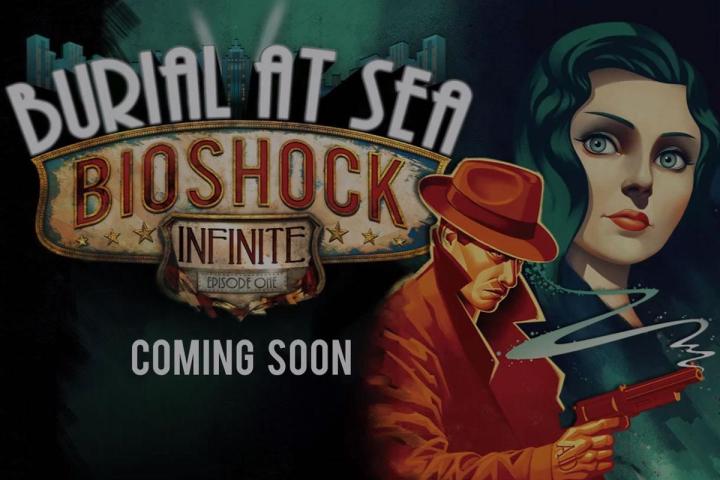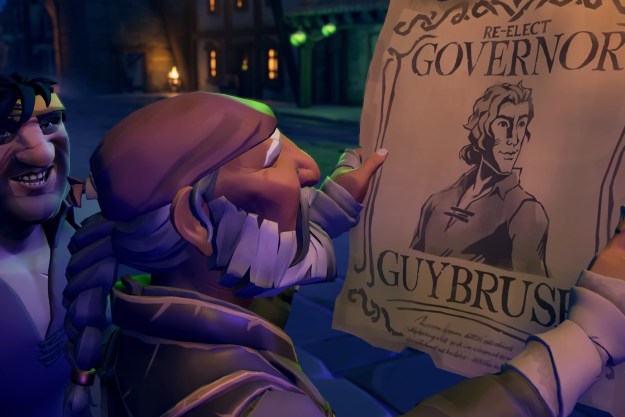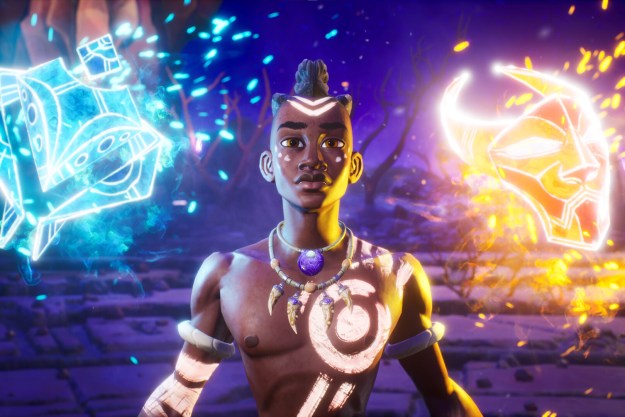
We’ve known since before BioShock Infinite launched in March 2013 that Irrational Games had post-release downloadable content plans in place. A Season Pass offering promised three packs that would “continue the player’s journey in the sky-city of Columbia with new stories, characters, abilities and weapons.” Now we’ve got the first details on what form that DLC will take. The first pack, which releases alongside the announcement, is “Clash in the Clouds,” an arena combat-focused add-on. But it’s the second one, the two-part, story-driven “Burial at Sea,” that has our attention. You can find the trailer at the bottom of this post.
The official documentation for the new story doesn’t say this explicitly, but it’s clear enough as soon as you watch the DLC’s reveal trailer: Irrational has embraced the aesthetic stylings of film noir. The voiceover, the writing, the restrained creepiness of the montage of everyday life in Rapture, the creative use of light and shadow in revealing Elizabeth… all of it owes its existence to Hollywood’s classic hardboiled detective stories even as it mixes in alongside the fantastical elements of Irrational’s utopian metropolis at the bottom of the ocean.
You might understand that there’s a body of source text being referenced here, but are you actually versed in the style and feel of film noir? Do you know where it comes from? Which shining examples you should check out? We’ve got multiple months to wait before even the first “Burial at Sea” episode is released. Might as well use that time to educate yourself. Just imagine how much more you’ll appreciate the new story as you take note of the meta-narrative elements that the Irrational team is playing with.
Understanding film noir
The term “film noir” originates with post-World War II film critics in France; it translates directly to “black film” or “dark film,” and it describes certain stylistic and narrative tendencies that are heavily informed by the Hollywood gangster films of the ’20s and ’30s. The violence and cynicism that highlighted the plots of those earlier films, as well as the creative use of light and shadow, carry directly into the hardboiled detective stories that film noir is awash with.

Instead of power fantasies that highlight a criminal’s gradual rise and rapid fall, you have stories that typically follow a deeply flawed male protagonist, sometimes a cop or private detective and sometimes a criminal, as he navigates his way through a deadly mystery. Cop or crook, it doesn’t matter; he’s often not a friendly guy. The film noir protagonist tends to embrace a negative outlook on the world. He doesn’t trust easily, and he’s often burned when he does.
That’s where the female characters come in. Women in these stories often fill the role of beguiling femme fatale. Occasionally they’ll find redemption, but usually not before double-crossing the protagonist or in some other way luring him into a deadly situation. The motivation is typically a selfish one: money, or some treasure that’s as valuable as a pile of cash, or even just straight-up self-preservation. The women of film noir aren’t inherently evil – not always, at any rate – but they are traditionally the deceptively friendly face of trouble.
These stories are further bound together by a third vital character: the big city. Most well-known examples of film noir cast a large metropolitan space as a character unto itself. Usually a dark character, cast in the shadows of night and concealed behind a thick veil of pouring rain. Filmmakers tend to lean on an abundance of high- and low-angle shots mixed with low-key lighting to highlight silhouettes and imbue an otherwise mundane setting with a sense of dread and menace. The story structure of film noir is informed by early gangster films, but the stylistic presentation has more in common with the German Expressionism of the 1920s; many would not incorrectly characterize Fritz Lang’s M. as a prototypical work.
A broad cross-section
Now that you’ve got a better sense of what film noir is, you can begin to explore some of cinema’s many takes on the style. This is a big category. There’s really no way to take an all-encompassing look. Or even a comprehensive one. Some of you are going to look at this list and ask where one movie or another is, and that’s fine. You are encouraged to share your favorites in the comments section. This list is a broad cross-section, a primer of sorts to prepare you for “Burial at Sea.” Some of these examples may not be Essential Works of Film Noir, but they’re the examples that sprang to mind as that reveal trailer played.

Please do share your own examples below. There’s always room for more recommendations. Hopefully, in seeing all of this, you get a sense of how Irrational and creative director Ken Levine draw from film noir. Not just for “Burial at Sea” either; consider BioShock Infinite again, even the original BioShock. Both of these stories draw heavily from noir tropes.
Phillip Marlowe is, in many ways, the definitive hardboiled private detective. Created by author Raymond Chandler, Marlowe is like the James Bond of shadowy detective stories. There’s no definitive chronology for his life, no set thread to follow through Chandler’s books. There’s just a hard-drinking, tough-talking private dick solving crimes and pulling off last-minute saves again and again. Many of Chandler’s works were adapted into some of film noir‘s best-known examples, including The Big Sleep (1946 and 1978), The Long Goodbye (1973), and Farewell My Lovely (1975). Yet for this list we’re pulling out the somewhat lesser-known Lady in the Lake, due to its unique and particularly gamer-friendly style of presentation.
Lady in the Lake (trailer right here) is presented almost entirely from the first-person perspective of actor/director Robert Montgomery as Marlowe. “The most thrilling of all mysteries,” the trailer’s text reads, “and you play the starring role.” The fixed perspective enforces some unusual creative constraints, but the story and feel are unmistakably rooted in film noir.
Widely regarded as the first true work of film noir, John Huston’s 1941 version of The Maltese Falcon (not to be confused with Roy Del Ruth’s 1931 take) is a bona fide classic. Humphrey Bogart stars as Sam Spade, the private detective created by author Dashiell Hammett. The Maltese Falcon is the only full-length novel that the character appeared in, though he was shaped by Hammett’s own experiences as a P.I. It is widely acknowledged that the Spade character directly informed Chandler’s own creative process as the Marlowe stories came together.
The Maltese Falcon (trailer right here) is very much a textbook example of film noir. The lighting and the camera shifts work to very effectively communicate thematic aspects of the story that wouldn’t otherwise play right as expository dialogue. They also work in concert to create an appropriately gloomy and mysterious mood. The story is similarly textbook, casting Spade’s San Francisco as a seedy city filled with ruthless opportunists and hired gunmen. There are other examples that more fully embrace the stylistic elements of traditional film noir, but this is where it all started.
Brick (trailer right here) is an outlier, a colorful murder mystery thriller built for spectacle-loving modern audiences. Black-and-white gloom is replaced by lush cinematography in a way that effectively evolves common notions of film noir. This was director Rian Johnson’s feature debut, and he’s cited Cowboy Bebop and Chinatown – which is its own sort of “neo-noir” – as key influences on his visual style. Brick feels almost as if it was shot through the eye of a still photographer, with great emphasis placed on highlighting large, open spaces and frozen character moments.
The story is pure film noir, a murder mystery that casts the central figure as a reimagined hardboiled detective. There’s a twist, however: the setting is a sleepy California suburb and the assembled players are, for the most part, high schoolers. Johnson, who also wrote the script, has fun playing with noir tropes in a high school setting, but never at the expense of tone. While there’s some dark humor scattered throughout, Brick‘s tale is a dark one. As with the best murder mysteries, no one can be trusted and nothing is as it seems.





